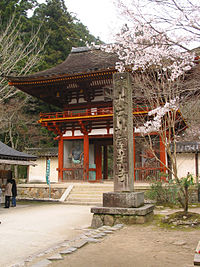- Niōmon
-
Main article: Mon (architecture)
The niōmon (仁王門 lit. Niō gate) is the Japanese name of a Buddhist temple gate guarded by two wooden warriors called Niō (lit. Two Kings). The gate is called Heng Ha Er Jiang (哼哈二将) in China and Geumgangmun (金剛門) in Korea.[citation needed] The two statues are inside the two posts of the gate itself, one at the left, one at the right. Structurally, it usually is either a rōmon or a nijūmon and can measure either 5x2 or 3x2 bays.[1] It can sometimes have just one story, as in the case of Asakusa's Kaminarimon.[citation needed]
In a five-bay gate, the figures of the two Niō are usually enshrined in the two outer bays, but can be sometimes found also in the inner ones.[1] The statue on the right is called Naraen Kongō (那羅延金剛) and has his mouth open to utter the first letter of the Sanskrit alphabet, which is pronounced "a". The left statue is called Misshaku Kongō (密迹金剛) and has his mouth closed, representing the last letter of the Sanskrit alphabet, pronounced "um". These two letters (a-un in Japanese) together symbolize the birth and death of all things.[2]
The two Niō Naraen KongōMisshaku KongōNotes
- ^ a b "Nioumon". JAANUS. http://www.aisf.or.jp/~jaanus/deta/n/nioumon.htm. Retrieved 27 August 2010.
- ^ Parent, Mary Neighbour. Japanese Architecture and Art Net Users System. A-un, retrieved on 9-28-10
Elements of Japanese architecture Styles Buddhist · Buke · Daibutsuyō · Gassho · Giyōfū · Hachiman · Hirairi · Hiyoshi (also called Hie) · Irimoya · Ishi-no-ma · Kasuga · Kibitsu · Nagare · Ōbaku Zen · Setchūyō · Shinden · Shinmei · Shinto · Shoin · Sukiya · Sumiyoshi · Taisha · Wayō · ZenshūyōA model of Himeji Castle
Building types Roof styles Structural Burdock piling · Chigi · Disordered piling · Engawa · Fusuma · Hisashi · Irimoya-zukuri · Irori · Jinmaku · Katōmado · Katsuogi · Kuruwa · Mokoshi · Moya · Nakazonae · Namako wall · Nightingale floor · Onigawara · Ranma · Shōji (see also washi) · Sōrin · Tamagaki · Tatami · Tokonoma · Tokyō · Tsumairi · ShibiGates and approaches Rooms Furnishings Outdoor objects Measurements Groups See also Buddhist temples in Japan Japanese Buddhist architecture Architectonic elements Mon (gates) Buildings Chinjusha · chōzuya/temizuya · -dō · main hall (kon-dō, hon-dō, butsuden) · kuri · kyōzō or kyō-dō · shoinTō or Buttō (pagodas) Styles Others A-un · kenSchools and objects of worship Major schools Zen schools Nanto rokushū Objects of worship Amida Nyōrai · Benzaiten · Dainichi Nyorai · Jizō · Kannon · Marishi-ten · Shaka Nyorai · Shitennō (Four Kings) · Twelve Heavenly Generals (Jūni Shinshō) · Yakushi NyoraiOther elements Implements kei (ritual gong) · mokugyōOthers bussokuseki · butsudan · Glossary of Japanese Buddhism · Japanese Buddhist pantheon · jingū-ji · miyadera · saisenbakoCategories:- Gates in Japan
- Japanese architectural features
- Japanese architecture
- Buddhism in Japan
- Buddhist art and culture
Wikimedia Foundation. 2010.




